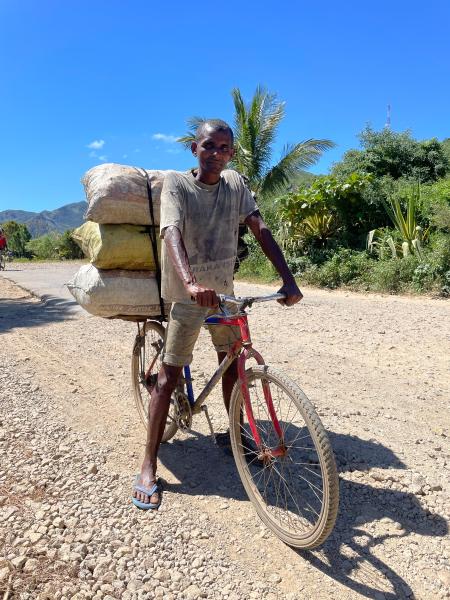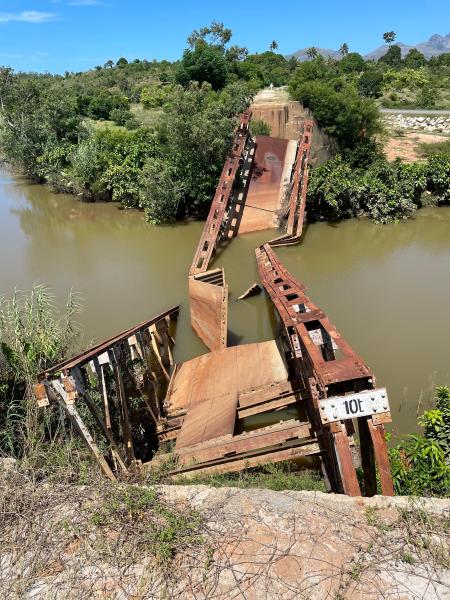Madagascar’s road network is damaged each year by extreme weather linked to climate change. Building new roads and modernising existing ones helps connect isolated rural populations and enables the development of international ports in the north and south of the country.
The island nation off the southern African coast is increasingly vulnerable to climate change. It faces frequent severe weather that causes drought and flooding. As a consequence, crop failure is widespread, resulting in food insecurity and internal migration. It’s a heavy burden on a population that already faces hardship.
Cyclones – like Tropical Cyclone Freddy, which hit in February – batter Madagascar each year, destroying large sections of the road network and making an already inadequate system impassable. According to the World Bank, 17 million of Madagascar’s rural population live more than 2 km from an all-season road. Better transport connections are vital to a country in which only 11% of the rural population has access to electricity.
The cost of repairing roads damaged or lost each year requires particular support in a poor country with 81% of the population below the poverty line.
“The main issue in Madagascar is the road infrastructure,” says Christophe Rakotomavo, the director general of the Madagascar Road Agency. “Madagascar is a very big island. There is a lot of area to be covered. It's hard to maintain the network because obviously the country is fairly poor. There aren’t enough taxes to pay for maintenance of the network.”
The consequences of climate change intensify these problems.
“You have cyclones,” Rakotomavo says, “so every year there is more damage to the existing network. Because of this, maintenance work doesn’t decrease in a normal way, so it involves more and more investment to sustain the network.”
The European Investment Bank paid out €73.6 million in December 2022 in the form of a €50.4 million loan and a grant of €23.2 million from the European Union to the road agency for work on the RN6 national road linking Diego Suarez (Antsiranana in the Malagasy language) and Ambanja in the very north of the island, and the RN13 highway between Ambovombe and Fort-Dauphin (Taolagnaro in Malagasy) in southernmost Madagascar.
The Madagascar government has ambitions to develop the port of Antsiranana in the north and Taolagnaro port in the south, linking them to better road networks. This is necessary because Madagascar imports many essential goods and relies on revenue from exports, including perishable luxury food items, notably vanilla and crustaceans.
“We collect, prepare and export frozen langoustines,” says Ivan Staub, the chief operating officer of Martin Pêcheur, a fish and seafood supplier which has a processing plant at Fort Dauphin. “To collect the langoustines, we have about ten pick-up trucks. To have the roads rebuilt is important for us, because our journeys are shorter. The shorter the journeys, the fewer langoustines die en route, which is bad for business.”
- Read more about EIB support for transport in developing countries
Opening Madagascar’s ports
Toamasina, on Madagascar’s eastern coast, is the country’s major port facility, handling about 80% of international maritime traffic. It is relatively well-connected by road networks to Antananarivo, including a ring road at the country’s capital that’s designed to reduce chronic traffic congestion and is nearing completion, with a €28 million loan from the European Investment Bank
Connecting the ports in the north-east and south-east with durable, safe roads is vital to the Madagascan economy. “Roads are the key to opening the ports in these regions”, says Pierre Sarrat, an engineer in the European Investment Bank’s Strategic Road Division. “It's critical that goods can flow in and out.”
The construction and rehabilitation of roads has a direct importance for the population, too. “The roads are needed to help fight famine in the south by being able to transport goods to the people that need it,” says Christelle Savall, a portfolio management officer at the European Investment Bank. “Construction work has to make sure people can still use the road, whatever happens. In some places in the south, the road is so damaged that big chunks of it are not usable at all. So it really has to be rebuilt”.

© Pierre Sarrat, EIB
His bicycle laden with heavy bags, Nahoda rides on a new road. “Before, the road was full of holes,” he says. “Now it’s flat. It's more enjoyable than riding in the holes.”
The project to modernise and build 348 kilometres of roads costs €235.5 million, including a grant of €116 million from the European Union and a loan of €110 million from the European Investment Bank, as well as financing worth €4.8 million from the Republic of Madagascar. A total of €100.4 million has already been paid to the Republic of Madagascar under this operation since 2016.
The European Union’s Global Gateway strategy
European Investment Bank financing to improve Madagascar’s road networks is part of the European Union’s strategy to support global transport connections. The European Union set up the Global Gateway strategy in 2021 to develop smart, clean and secure links in the digital, energy and transport fields and to strengthen health, education and research systems worldwide. The Global Gateway intends to mobilise up to €300 billion of investment in key infrastructure around the world between 2021 and 2027.
“The Global Gateway really is at the core of what we at the European Investment Bank are doing outside the European Union,” says Sven Röben, head of the Neighbourhood, Development and International Cooperation Instrument Unit at EIB Global, the European Investment Bank’s arm for operations outside the European Union.
Planning for safer roads
The European Investment Bank granted €4.7 million to the RN 6 and RN 13 roads project for technical assistance, which included audits of road safety that looked at road users and pedestrians.
“Safety is very important when planning road improvements,” says the EU bank’s Savall. “Decisions to change traffic flows must protect against increasing casualties. While sometimes painted concrete road signs are the only option, it's very dangerous, because if cars collide with concrete the risk of mortality is increased. So audits for safety are very important to make sure road improvements are done well”.
“The RN 6 crosses a number of villages and settlements, with many schools located on the road corridor. At the moment, the dilapidated condition of the road means traffic can’t travel fast, but the project will most certainly lead to a sharp increase of vehicle speed and risk of collisions. We are therefore integrating a set of safety measures all along the road to mitigate this risk and force road users to slow down in urban areas,” explains Sarrat.
Building resilient roads, training skilled labour
The road construction project on the RN 13 has created opportunities for local people to gain job skills and employment.
“The region near the RN13 is very remote in Madagascar and is very poor,” says Benoit Turmine, director of infrastructure contractor Colas, who heads the road project at Fort Dauphin. “Unfortunately, it is an area with low agricultural capital. We are promoting manpower by training participants to be masons, carpenters, frame workers, and metal workers. Our expectation is that the workers we train will go on to train others.’’
New and repaired roads are built to international standards, often replacing dirt tracks that are swept away during cyclones. Some stretches of the roads have bridges. These structures have been strengthened to improve their resilience to adverse climate events.
“The design of all bridges and hydraulic structures has been updated to take account of climate change, and the pavement structure of the RN6 has been reinforced to comply with modern standards,” Sarrat explains.

© Pierre Sarrat, EIB
Final year students from a Malagasy-Canadian management school in Madagascar are assigned to the roads projects to learn about project management. “They train with the project manager to make sure that they learn to work on an international-scale project and make sure that they can replicate this in future projects they work on,” says Rakotomavo of the Road Agency. “Last year we had four students, with three working on the RN 6 road and one on the RN 13. We want them to understand what international standards looks like.”
- Listen to the Climate podcast: Transport solutions for a cleaner world
